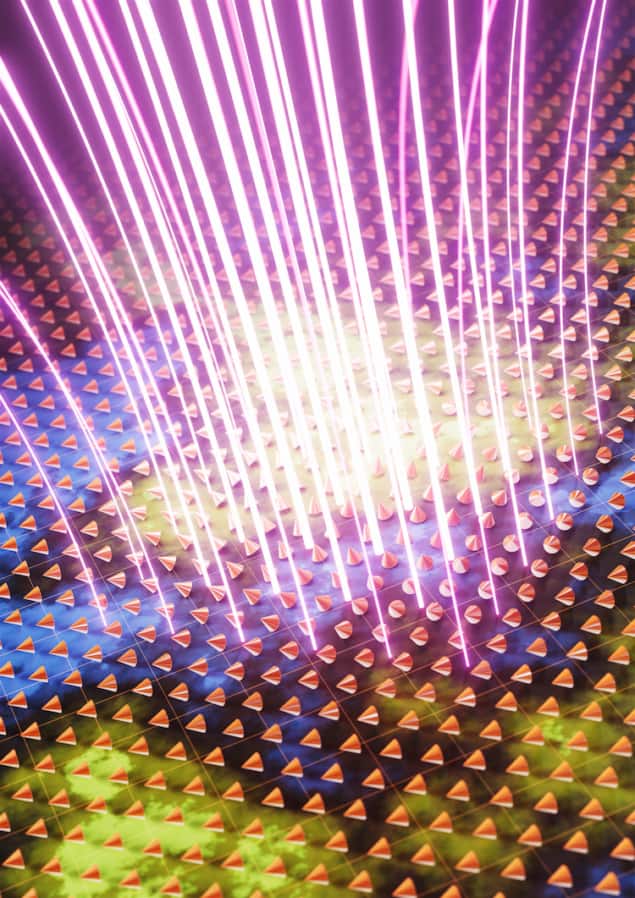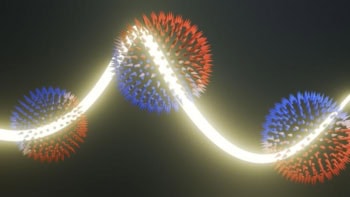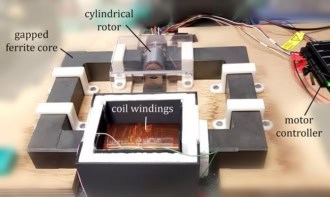
Physicists at the universities of Oxford and Cambridge in the UK have spotted signatures of magnetic monopoles and other unusual magnetic structures in haematite, a naturally occurring antiferromagnetic iron oxide material. The structures, which the researchers discovered using quantum sensing measurements, could form the basis for novel devices such as racetrack memories and super-fast, energy-efficient neuromorphic computing.
An ordinary bar magnet consists of a north and a south pole. Slice it in two, and each of the resulting halves – no matter how small – will also have two poles. Indeed, the bipolar nature of magnetism is so fundamental that it crops up in Maxwell’s equations, which imply that although isolated positive and negative electric charges exist, isolated magnetic charges cannot.
During the quantum revolution of the 1920s and 1930s, some physicists began to speculate that this principle of classical electromagnetism might need revising. In 1931 Paul Dirac became the first to predict that magnetic monopoles – elementary particles that act as isolated magnetic north and south poles and are the magnetic analogues of electric charges – could exist. Although magnetic monopoles of the type Dirac envisaged have never been seen as free particles, exotic materials known as spin ices have since been found to host collective states that mimic them.
Swirling patterns of magnetic charges
A team of researchers led by Mete Atatüre, the head of Cambridge’s Cavendish Laboratory, has now observed a similar “emergent” type of magnetic monopole in haematite. These monopoles are collective states of many swirling spins (inherent angular momenta of electrons) that, together, act like a localized stable particle with a magnetic field emanating from it. “These ‘antiferromagnetic whirls’ (which are called merons, antimerons and bimerons) in haematite are associated with ‘emergent magnetic monopoles’,” explains the team’s co-leader Paolo Radaelli, a physicist at Oxford. “These whirls give away their location and we are able to study their behaviour with diamond quantum magnetometry and other scanning techniques.”
In diamond quantum magnetometry, a single spin in a tiny needle made of diamond is used to precisely and non-invasively measure the magnetic field on the surface of a material. “Quantum magnetometry can sense very tiny magnetic fields,” Atatüre explains. “Hence, it is ideally suited to map the magnetic order in antiferromagnets, a special class of magnetic materials in which the local magnetization nearly cancels out.”
A new approach pays off
The researchers, who report their work in Nature Materials, spotted several unusual magnetic structures in haematite using this technique, including two-dimensional monopoles, dipoles and quadrupoles. This is the first time a two-dimensional monopole has been observed in a naturally occurring magnet, they say. Radaelli adds that the team was not expecting to see much because antiferromagnetic spin textures were considered elusive and only observable using complex X-ray techniques.
“We sent our samples to Mete and colleagues in Cambridge without knowing exactly what to expect,” he says. “I recall discussing this and thinking that we would see nothing. When the images from Cambridge started pouring in, we debated different interpretations until quantitative simulations revealed the microscopic origin of the signal.”
It was only at this point that the team understood the monopolar nature of the observed magnetic structure and made the connection with examples of monopoles in the scientific literature, he tells Physics World.
Readout and classification
As for applications, team member Hariom Jani, a postdoctoral fellow at Oxford and the first author of the study, suggests the newly observed monopoles could serve as indicators for other unusual effects. “The interconnection between the magnetic charges, which are the sources/sinks of tiny fields, and the winding sense of the antiferromagnetic whirls is quite useful because it opens up an easy pathway to read out and classify exotic antiferromagnetic states,” he says.

Magnetic monopoles found lurking in topological chiral crystals
His Cambridge colleague, PhD student Anthony Tan, agrees. “Our work highlights the potential of diamond quantum magnetometry to uncover and investigate hidden magnetic phenomena in quantum materials, which could help pioneer new fields of study in this area,” he says.
The team’s ultimate goal, Radaelli says, is to construct real-world devices for next-generation computing that make use of these antiferromagnetic whirls. “We are working in parallel on two separate concepts: one based on emulating biological neurons; and the other on so-called racetracks, that is, nanoscopic ‘highways’ for the whirls,” he says. Constructing such devices will require electrical contacts, leads and transducers to be fabricated at the nanoscale, he adds: “We anticipate that multi-probe scanning techniques, such as diamond quantum magnetometry, will enable us to fast-track this work.”



